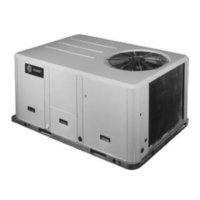Unit Start-Up
50 RT-SVX21K-EN
4. To stop the SERVICE TEST, turn the main power
disconnect switch to the “Off” position or proceed to
the next component start-up procedure. Remove
electromechanical test mode connections (if
applicable).
Compressor Start-Up
1. Attach a set of service gauges onto the suction and
discharge gauge ports for each circuit. Refer to the
refrigerant circuit illustration in the Service Facts.
ReliaTel Control:
Momentarily jump across the Test 1 & Test 2 terminals
on LTB1 one additional time if continuing from
previous component start-up or until the desired start-
up component Test is started.
Electromechanical Control:
Using the Service Test Guide perform the proper test
mode connections.
Scroll Compressors
a. Once each compressor has started, verify that the
rotation is correct. If a scroll compressor is rotating
backwards, it will not pump and a loud rattling
sound can be observed.
b. If the electrical phasing is correct, before
condemning a compressor, interchange any two
leads (at the compressor Terminal block) to check
the internal phasing. If the compressor runs
backward for an extended period (15 to 30 minutes),
the motor winding can overheat and cause the
motor winding thermostat to open.
2. After the compressor and condenser fan have started
and operated for approximately 30 minutes, observe
the operating pressures. Compare the operating
pressures to the operating pressure curve in the
Service Facts.
3. Check system superheat. Follow the instruction listed
on the superheat charging curve in the Service Facts.
Superheat should be within ±5 F of the superheat chart
value.
4. Repeat steps 1 through 4 for each refrigerant circuit.
5. To stop the SERVICE TEST, turn the main power
disconnect switch to the “Off” position or proceed to
the next component start-up procedure. Remove
electromechanical test mode connections (if
applicable).
Dehumidification Option
Momentarily jump across the Test 1 and Test 2 terminals of
the LTB1 until the unit enters test mode 7 (See Table 10,
p. 44). Once the unit is in the reheat test mode, verify that
the 3 way valve has shifted to the reheat position and that
the supply temperature rises 10°F more than when in
cooling mode stage 2.
Monitor the suction pressure for 15 minutes. The suction
pressure should remain within 5 psi of normal cooling
operation.
Gas Heat Units
Open the main disconnect switch to shut the unit off and
to reset the RTRM.
ReliaTel Control: Follow the Test Guide in Table 10, p. 44
to start the unit in the heating mode. Momentarily jump
across the Test 1 & Test 2 terminals on LTB1 one additional
time if continuing from previous component start-up or
until the desired start-up component Test is started.
Electromechanical Control. Using the Service Test
Guide perform the proper test mode connections.
When starting the unit for the first time or servicing the
heaters, it is a good practice to start the heater with the
main gas supply turned “Off”.
Once the ignition system and components have been
checked, open the main power disconnect switch to reset
the unit.
Final System Setup
After completing all of the pre-start and start-up
procedures outlined in the previous sections (i.e.,
operating the unit in each of its Modes through all
available stages of cooling & heating), perform these final
checks before leaving the unit:
• Program the Night Setback (NSB) panel (if applicable)
for proper unoccupied operation. Refer to the
programming instructions for the specific panel.
• Verify that the Remote panel “System” selection
switch, “Fan” selection switch, and “Zone
Temperature” settings for automatic operation are
correct.
• Inspect the unit for misplaced tools, hardware, and
debris.
• Verify that all exterior panels including the control
panel doors and condenser grilles are secured in place.
• Close the main disconnect switch or circuit protector
switch that provides the supply power to the unit’s
terminal block or the unit mounted disconnect switch.

